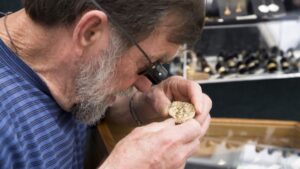When it comes to gold deposits, grade is NOT king

Pic: Bloomberg Creative / Bloomberg Creative Photos via Getty Images
In mineral exploration and development, especially gold, there aren’t many sayings more ubiquitous than ‘grade is king’.
This well-worn proverb infers that higher grades are important above all else to the economics of a potential mining operation.
Of course, all else being equal higher grades are king. But things are never equal between mining operations.
Factors like orebody depth, metallurgy, size, and mineralisation style differ wildly and play a massive part in measuring all in sustaining costs (AISC) – that’s the amount it costs an operation to produce one ounce of gold.
Sam Ulrich, director at Perth-based Aurum Analytics, says gold grades “are not the be-all and end-all”.
“At the individual deposit level grade is king, but when comparing two or more deposits it is not,” he told Stockhead.
“When you start comparing different mines – that’s when the idea can fall down.
“One deposit/mine’s 7g/t might be equivalent to another’s 4g/t.”
Let’s look at Australia’s lowest cost mining operations.
In the June quarter this year, Evolution Mining’s (ASX:EVN) share of the Ernest Henry operations was the lowest cost producer, reporting an AISC of $-644/oz followed by Newcrest Mining’s (ASX:NCM) Cadia Valley operations with an AISC of $174/oz.
Both these operations boast average gold grades of less than 1g/t.
And yes, you read that right — negative $644/oz. That’s because both these operations benefit from significant base metal by-products.
And even if you take these base metals credits out of the equation, the lowest cost “gold only” operations were Kirkland Lake Gold’s (ASX:KLA) Fosterville mine with an AISC of $454/oz (39.9g/t), then Alkane Resources’ (ASX:ALK) Tomingley mine at $807/oz (1.2g/t) and Saracen’s (ASX:SAR) Thunderbox mine at $897/oz (2g/t).
Those grades vary wildly. The #2 highest grade producer at 9.9g/t was St Barbara’s (ASX:SBM) Gwalia mine – which came in at position 22 on the AISC rankings for the June quarter.
Clearly there’s other factors involved here besides grade. What should punters keep an eye out for?
Ulrich says you can almost simplify it down to grade, geology, geometry and even geography if you are looking globally.
1. Don’t compare mineralisation styles
Comparing results between mineralisation styles just doesn’t work.
“In my opinion, you definitely need to separate deposits by mineralisation style — orogenic, epithermal, porphyry, IOCG (iron oxide copper gold) and so on,” Ulrich says.
“The two lowest cost mines Ernest Henry (iron oxide copper gold) and Cadia (porphyry) are low grade compared to Fosterville (orogenic) – probably the highest grade [gold] mine in the world at present,” Ulrich says.
“But both Ernest Henry and Cadia benefit from copper credits.”
Because of these credits and their easy-mining large volumes, porphyry orebodies can be economic from really low grades.
The downside is that to develop them requires a huge amount of capex — something a small company can’t do without a large company as a partner, Ulrich says.
“You could be up for a $1 billion-plus capex,” he says. “The little explorer can’t do that.”
2. Depth: Open Pit v Underground
Grades can vary considerably for similar AISC depending on whether the gold ore is extracted via open pit (shallow and less expensive) or underground (deeper and more expensive).
In its June Quarter report, Aurum Analytics found for the companies that report AISC, the average reported grade was 3.58g/t.
Open pit and underground operations averaged 1.67g/t and 5.77g/t respectively, while combined open pit/underground operations averaged 2.27g/t.
The ‘grade is king’ mantra is not always evident in open pit mines, says Ulrich — other factors, such as strip ratio, come into play.
‘Strip ratio’ refers to the ratio between the amount of waste (dirt or rock) that must be removed to extract one unit of gold-bearing ore. The lower it is the better.
3. Orebody Size & Thickness
The scale of the operation is important, which generally relates to the ‘geometry’ of the orebody.
“Smaller operations are generally higher cost than larger operations,” says Ulrich.
And thickness of the mineralisation is very important.
Are things like thin widths combined with a steeply dipping orebody a red flag for investors?
Potentially yes, Ulrich says.
“Once true width gets below 1m it can have issues as there are minimum mining widths which will dilute the grade,” Ulrich says.
“[ex Doray Minerals mine] Andy Well is a good example. That was quite narrow at a reasonable grade. The problem was that it was getting too thin and too diluted when they mined it.”
4. Metallurgy: the simpler the better
“Metallurgy is more—is [the gold] really fine grained? Is there carbonaceous matter, which means you have to spend more money on reagents and the like?” says Ulrich.
If an operation is getting over 95 per cent gold recovery through the mill that’s very good, he says.
“Most of the deposits out there are over 90 per cent. There are some that have extra metallurgical issues and are down in the 80s — you have to be wary of some of the operations that hit that 80 mark especially when arsenic is involved, which provides an extra environmental issue to overcome.”
NOW READ: Gold stocks guide — Here’s everything you need to know
UNLOCK INSIGHTS
Discover the untold stories of emerging ASX stocks.
Daily news and expert analysis, it's free to subscribe.
By proceeding, you confirm you understand that we handle personal information in accordance with our Privacy Policy.








